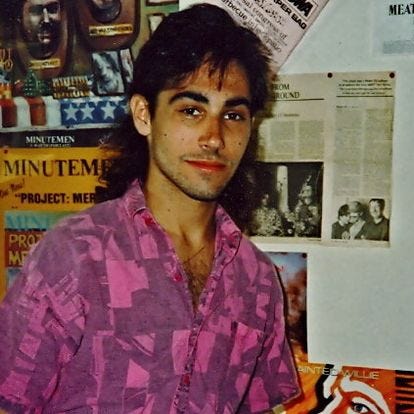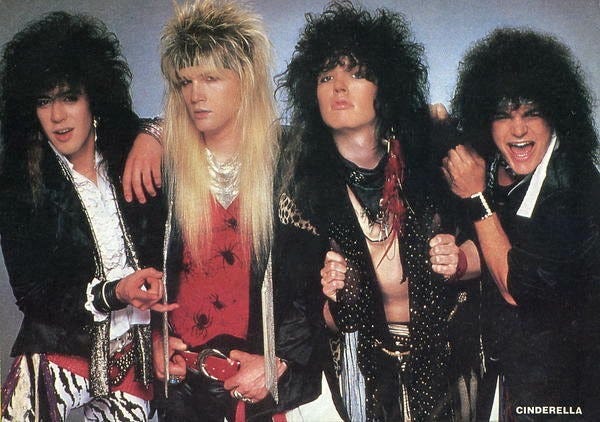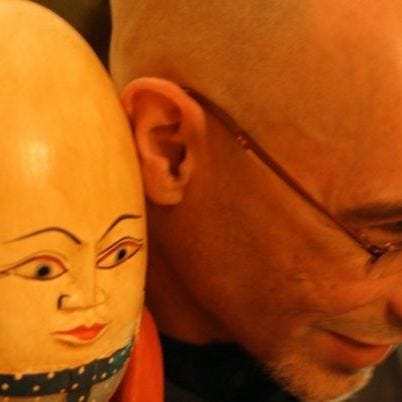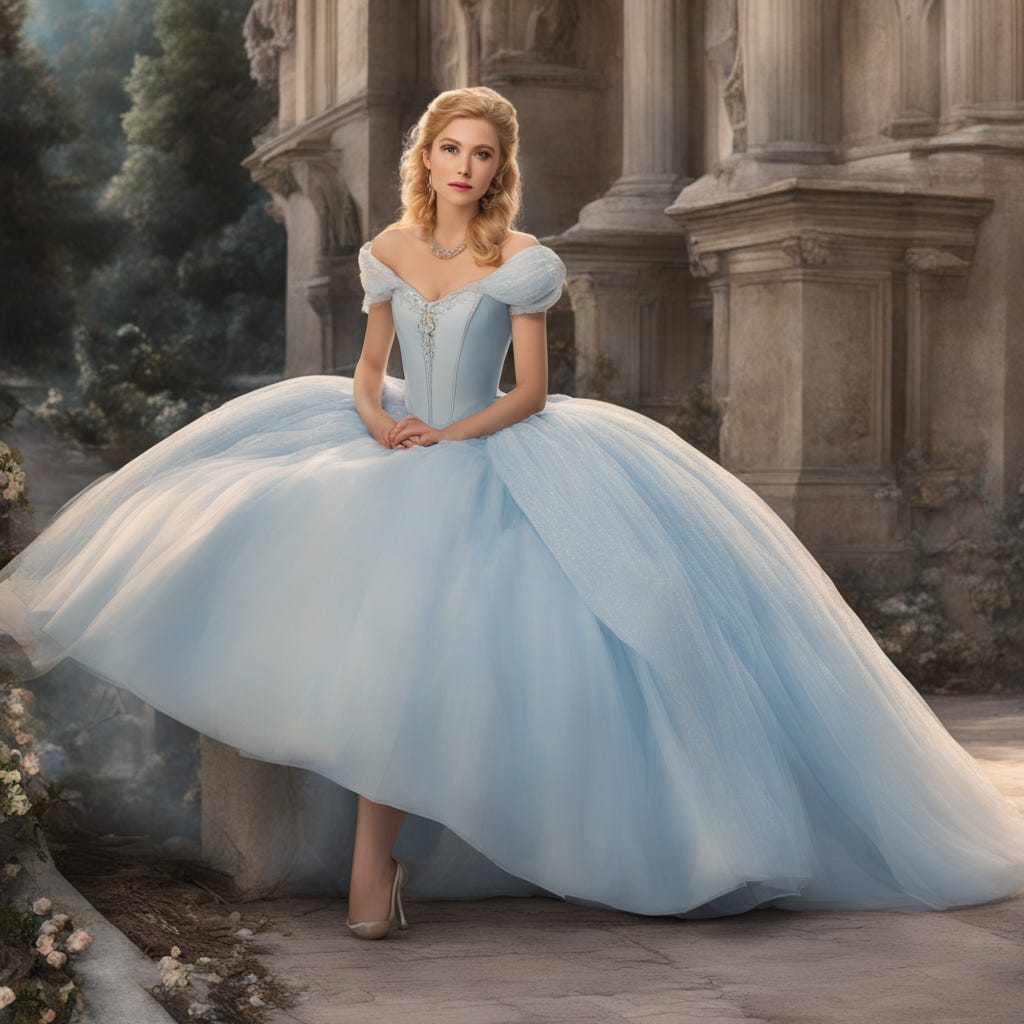Cinderella - Don't Know What You Got (Till It's Gone) - Revisited
Hair Metal, like my own luscious locks, disappeared soon after it arrived
I wish I’d have learned about the importance of accepting impermanence when my hairline began receding back in high school.
I have a distinct memory of standing at my locker at Granada Hills High School (in Southern California) and my friend Scott Zimmerman coming up to me, pushing my greasy bangs back and uncovering my oversized forehead. At witnessing this cavernous cranium he cried out, “You are so going bald!” Then he laughed maniacally like he’d discovered that I had a 3rd eye.
Sure, Scott could have been less enthusiastic at the reveal of my future glabrousness, but I’m making it sound meaner than it was. High school boys razz each other and point out each other’s perceived weaknesses.
Besides, it’s not as if I was unaware of what was in store for me. Proof that I would soon be as bald as Telly Savalas, as hairless as Captain Stubing from The Love Boat, as cue-balled as Peter Garrett (lead singer of one of my favorite bands, Midnight Oil), could be found plastered across the walls of my house. Every day, going up and down the stairs to and from my bedroom I would pass by the framed wedding photos of both sets of grandparents — my Papa Al and Papa Harry’s smiling 20-something faces beneath mostly bald heads. Back then, men did not shave the smiley-face ring of hair that travelled from just above one ear around the occipital ridge to the other ear. I call it the constant reminder ring.
There’s probably a sensible medical reason why that area of the head was/is allowed to maintain its hirsuteness while the rest of the head is fated to wave bye-bye to the follicle. I invite those in the know to educate me in the comments.

I would be gifted a few more years of luscious-locks ownership before having to face the mane descent. I, for some reason, chose to spend them with an unfortunate shaggy mullet during the first couple years of college (see above).
But as soon as I moved to the Bernal Heights neighborhood in San Francisco in 1993 at 26, I decided to embrace my natural, follicle-free destiny. I planned a head-shaving party and invited all my friends to come and take turns with the electric razor, shaving off my hairy past and welcoming me into a new, clean, sleek future.
I have done the math, and I’ve figured that I’ve saved more than 2700 dollars on professional haircuts and stylings in the 30 years I’ve been shaving my head myself. My numbers might be faulty as I have no idea how much haircuts actually cost or how often men usually get their hair cut. I was going with 4x/year at 25 bucks a pop at someplace like Supercuts (accounting for inflation across three decades). Then I’m subtracting the approximately 200-300 dollars spent on new head-shaving devices.
I also feel I must consider time in my calculations. I’ve saved a ton of it not having to “do” my hair each day. But I have, on average, shaved my head 2 to 3 times a week, and each time is about 10 minutes, so that should be considered. Also, the time at salons, which I have figured to be 128 hours if each haircut was an hour (including driving to and from salon) and 32 x 4 being the number of haircuts I’ve avoided. 128 hours is, according to my calculations, 5.333333 days. So I’ve gained 5 and 1/3 days of life by going bald. Probably double that if I was smart enough to shave my head while doing the dishes or preparing breakfast.
When I first shaved my head back in 1993, there were some unfortunate connotations that came along with it. Men with shaved heads were called skinheads. And skinheads were thought to be scary and mean. I really didn’t have to worry about that though, as, being 5 feet 2 inches, even with a shaved head, scary would not be an adjective used to describe me. Hopefully not mean either.
I wrote about being short in another essay — if you haven’t read it, check it out here:
It was nothing like today when it seems like more than a third of men over the age of 35 are bald and shave their heads. I don’t want to sound like a conspiracy theorist, but I’m pretty sure this increase in male baldness occurred at the same time as the widespread use of the internet.
I am grateful that baldness is so much more accepted in today’s culture than it was when I was growing up. But negative connotations with shaved heads still exists. I found this interesting article published a few years ago in the Independent (listed as written by “a man suffering from alopecia”) asking Hollywood to stop portraying bald men as evil villains. Personally, I don’t have a problem being portrayed as evil. As long as I’m not seen as an evil skinhead.
One possible reason that I was never much of a fan of the hair metal genre, is that all the teased, permed, lion-maned hair styles so prominent in that scene felt like a slap in the face. Like a slap on the scalp. A constant reminder of what I’d never have.
In heavy metal and hard rock, genres also famous for glorifying the long-haired musician, there were always exceptions to the rule. Rob Halford, lead singer of Judas Priest. Scott Ian of Anthrax. Billy Corgan of Smashing Pumpkins.
In the Hair Metal world, it seemed, being bald was not an option. If Hair Metal was a kid in a tree house, the wooden plank sign outside the entrance would say, “No baldies allowed.”
It was becoming impossible to ignore the influx of interchangeable hair-spray and lipstick bands, each one trying to differentiate themselves by how high off their heads they could get their hair to stand. These bands acted like they were rocking hard and some did incorporate glam elements in their sound in way I could get behind. But most of the songs and videos on MTV seemed to be focused on posing, posturing and out glamouring the scantily clad women (often seen cavorting in cages, or sucking on cherries or ice cubes) in their videos. The songs themselves lacked genuine, passionate, inspired songwriting chops. There was a hair metal formula and most of the bands were happy to stick to it.
That said, some of my favorite songs from the ‘80s come from a few of those so-called hair metal bands. “Every Rose Has It’s Thorn,” by Poison. Ratt’s “Round and Round.” Despite my attempts at pushing them out, these songs wormed their way deep into my skull, and 30-plus years later they still reemerge to show their (now wrinkled and botoxed) faces and Rogained scalps.
My favorite of the hair metal bands was Cinderella. Though visually they fit the stereotypes and checked all the cliché boxes (big hair, lots of makeup, girls in cages), musically they showed surprising range during their reign (4 albums over 8 years). They could pull off blues rockers ("Bad Seamstress Blues"), add a bit of country twang ("Shelter Me"), pull off some serviceable soul ("Love's Got Me Doin' Time"), honor their forebears with AC/DC-style hard rock ("Hell on Wheels") and — completing the requirement for true hair metal super-status — master the power ballad.
The successful power ballad must, must, must start off with a solo acoustic guitar or better yet a piano, the accompanying music video filmed atop a cliff-side at sunset or in the middle of a wintry blizzard outside a rustic cabin. A buxomy "rock chick" (with hair much shorter than all the men in the band) would need to be filmed walking aimlessly but with purpose, heading (we would discover) to the exact spot where the full band would magically appear, on a spooky soundstage surrounded by giant cages and candelabras.
Cinderella's video for their 1988 hit song, "Don't Know What You've Got (Till It's Gone)" meets all of these benchmarks and then some. We get the solo grand piano on the beach, acoustic guitars, cliff-side silhouettes and sunsets. No scantily clad women here though — likely because this was a "serious" song and the band was trying to rise above the sexist cliches.
I have to admit that despite my aversion to the genre, "DKWYG" is catchy-as-hell and hits just the right emotional/cheesy notes. It builds and swells like the perfect surfer's wave, and offers a universal, timeless lyrical message.
The truth embedded in the song's title is inarguable. It was true back in the '80s, it's true today, it was true a hundred years ago, and a hundred years from now it'll still be true. It's the human condition. We will never fully appreciate what we have until it’s no longer there.
But a song like this needs more than a strong melodic, dynamic sense and a universal message. It needs a vocalist who can pull it all off with aplomb. Who can express his sensitive, hirsute power when both quiet and loud.
Cinderella had one of the best in Tom Keifer. Keifer had the perfect blend of gravelly screech and expressive tone. One part Axl Rose, one part Bret Michaels, with a truer sense of his instrument than either.
He also plays a mean guitar, taking the lead on many of the guitar solos on their records. It’s Keifer playing the slide guitar on "Shelter Me" (below) and, as shown in the video above, he can twinkle the ivories too. He was (and is — he’s touring and recording under his name now) a true musician. The rest of the band fit into their roles well, but Keifer clearly was the main force in Cinderella.
I was lucky enough to see Cinderella in concert around 18 years ago, when they opened for Scorpions on the first of their "farewell" tours (Scorpions, not Cinderella, though it may have inadvertently been Cinderella's farewell tour as well). I had forgotten about them at the time, having gone to the show to see the Scorps, but was amazed at how many of their songs I recognized.
"Wait, this song was Cinderella? And this one is Cinderella too?”
My appreciation for the band — and I have to hand it to them for not spelling their band name Sinderella, which 99% of the other hair bands would have done — came well after their heyday.
I’m able to appreciate more music from this genre now than I was able to during the short window of its popularity. Seeing many of these musicians, most of them my age or older, with thinning hair, chubby bellies and wrinkled, weathered skin shows that time is the great equalizer.
I hear the message in “Don’t Know What You Got (Till it’s Gone)” as a call to pay attention. That we don’t have to wait until something or someone is gone to realize what we had. I’m trying to do this by appreciating and finding gratitude for all the people and things in my life that I love, that bring me joy.
It’s a life-long work in progress.
What in your life did you not realize what you had until it was gone?
Thoughts on hair metal? A guilty pleasure? A pleasure without guilt? Never liked it, never will?
If you were old enough to live through the hair metal years, did you participate in the big-hair styles of the day?










I'll see your Dont Know What You Got and raise you a Nobody's Fool
Great article! I had the mullet and was clipping Husker Du and Minutemen articles in '87 as well. I saw Cinderella open for AC/DC around that same time and they were pretty good!